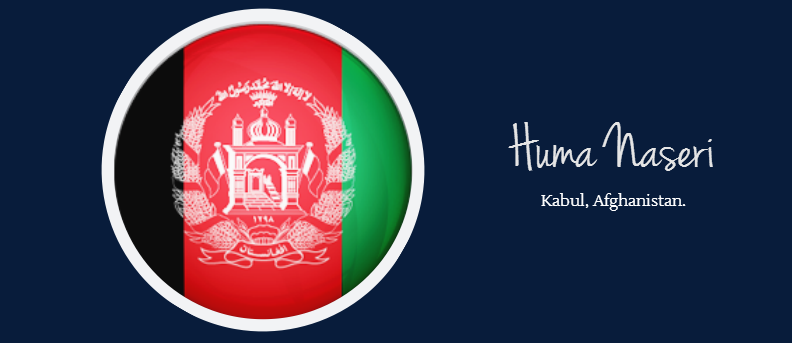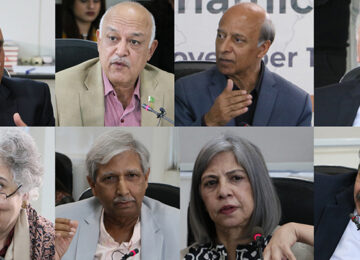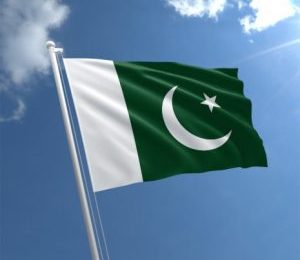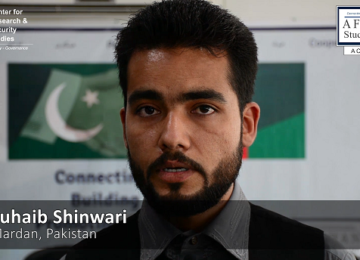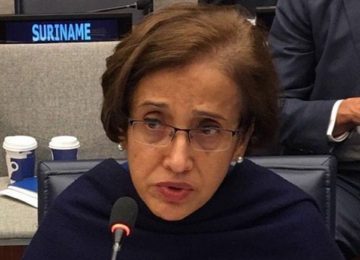Huma Naseri is an Afghan writer and an ethnic Pashtun female residing in Kabul, Afghanistan. She attained her Master’s degree in International Relations from Germany and is currently pursuing her Ph.D.
![]() When it comes to relationships between Afghanistan and Pakistan, the perception is based on antagonism to its peak on either side of the border. This historical aversion allows us to critically think about the root causes of conflict between both countries.
When it comes to relationships between Afghanistan and Pakistan, the perception is based on antagonism to its peak on either side of the border. This historical aversion allows us to critically think about the root causes of conflict between both countries.
After the creation of Pakistan in 1947, based on a neutral history of the region from non-related players, Pakistanis have often expressed their fundamental threat from its western hemisphere as well as its eastern borders. This threat is genuine as Afghanistan was the first to veto Pakistan’s creation in 1947. Since then, Pakistan’s foreign and national strategic polices were built and pursued on countering major threats from both hemispheres to Pakistan’s national interests.
On the other side, the pre-dominantly Pashtun regions, known as “Pashtoonistan,” is considered to be an integral part of Afghanistan’s territory, where the main pivot among both nations is the pivotal Durand line of 1893, which Pakistan claims to have resolved with Afghanistan. Yet, Afghanistan contradicts Pakistan’s claim that a resolve has been determined, saying that the conflict of the border is yet to be discussed with Pakistan. This whole ordeal has thus created an atmosphere of animosity between both nations, which is now elevated to new heights.
However, it is almost forgotten that there is a colossal difference between perception and reality. Perception is what you see and reality is what is or, in other words, reality is the way things actually are; perception is our interpretation of reality. To me, the animosity between Afghans and Pakistanis is just a matter of ‘perception’, not reality, and if it is simply perception then how are we to overcome it? One of the best ways would be to create a platform where people can interact with each other, ensuring that they do not become negatively influenced by what the media represents.
Thus, based on bilateral interactions between Afghan and Pakistani youngsters, a more progressive approach is sought and persuaded. Bearing that in mind, the civil society took initiatives of inviting a group of Afghan civil society members to Pakistan to talk about building bridges of trust and peace between the two nations (as both nations share a lot in common). Few of us were first-time visitors to Pakistan, while other members of the Afghan team, including myself, spent a large chunk of their lives in Pakistan. During one of the initial meetings, I recalled the attitude of one of the Afghan team members, who was a first-time visitor to Pakistan, while expressing his feelings towards the big input between both countries. He said:
“Prior to my arrival in Pakistan, I had thoughts of facing some challenging and offensive interaction from the Pakistani team; but, after our first meeting, I was surprised by the likelihood and the positive interaction conducted by the Pakistani team, which has now changed my perception.”
He also went on to express his overall feelings about his visit and admitted that his negative sentiments and perceptions about Pakistan have further changed dramatically.
The reaction of my fellow Afghans reminded me of my first time visit to the United States, where I stayed for a period of one month, while attending an educational course on non-violence and peace at the Rhode Island University. This was also my first time being amongst multi-national students gathered in one location. During my educational program, my American fellow stood up and said that he always felt very disheartened whenever he heard about the deaths of Americans in Afghanistan, but after having met me — an Afghan — he will, from now onwards, feel the same pain for the suffering and deaths of Afghans.
The statements, made by both my Afghan and American fellows, bring our attention to one common point: by interacting with each other, we have a tendency to quell stereotypes on each other. Further, our goal in Pakistan was achieved double-folded, where the first goal was to build on good relationships and eradicate any misconceptions. Both the Afghan and Pakistani groups acted as a bridge to connect two nations. We all tried our best to share our thoughts and ideas in a civilized and respectable manner. We discussed how immature the statements of the politicians are and how they can negatively impact the two nations, resulting in a lose-lose situation. Besides, by instigating violence and animosity among both nations, who will be the winners/losers? Is it the politicians and their kids, or is it the ordinary citizens of both countries who are suffering from the wrong policies enforced by the government? To me, it is the ordinary citizens of both countries!
We never stop to pause and think about those who make us fight and suffer, while they, themselves, enjoy their luxurious life. It is we, the young generation of both countries that will have to work hard and make every effort possible to achieve sustainable peace. Hence, it is we, as a nation, who vote and elect governments.
Further, a great case example is the Azerbaijan-Armenian border dispute over Nagorno-Karabakh due to the peace-making efforts that took place between both countries. Thus, Afghanistan and Pakistan should look into similar peace initiatives in order to bring about peace and stabilization. Also, during the tension between Azerbaijan and Armenia, the mothers of the soldiers of both countries played an important role by raising their voices as a slogan of peace: “Those who die on the borders of both countries are our sons.” Armenians also placed heavy pressure on their government to give the occupied land back to Azerbaijan so as to put an end to the conflict.
Moreover, both Afghanistan and Pakistan are peace-loving nations and share a lot in common. Even during my stay in Pakistan, I never felt like I was a foreigner in that country. While most of our religious and cultural interactions could be a juncture for sharing new ideas and new approaches, our languages are so easily understood that many words are already shared in both the official languages of the countries. This can thus lead to many economic advantages, since both countries are dependent on each other in various ways, when it comes to the ground-lines of communication. Yet, at the same time, the major challenge to today’s youth is that they belong to diverse societies where some narratives and misconceptions have filled their hearts with unnecessary animosity towards each other, which can only be cured through a sound and interactive communication.
At the end of the day, we are all human and have made past mistakes, considering the fragile relationship between Afghanistan and Pakistan. We, the youth, need to come forward and use the realities versus opinions/perceptions paradigm, and act according to our critical thinking in order to drive forth the peace-building efforts. Both nations must discover their talents and capabilities, and should not be hesitant to share those skills, in order to establish a more prosperous and positive relationship in the future. ![]()
About Afghan Studies Center: The Afghan Studies Center is an initiative by the Center for Research and Security Studies, Islamabad – an independent and non-profit think tank and advocacy center. One of the primary objectives of the Afghan Studies Center is to serve as a bridge between the youth of Pakistan and Afghanistan to interact with each other and join hands to become leaders of change and messengers of peace and cooperation beyond boundaries. To achieve this objective, the Afghan Studies Center invites young Afghans to share their story using our platform with the youth of Pakistan as well as the world.



